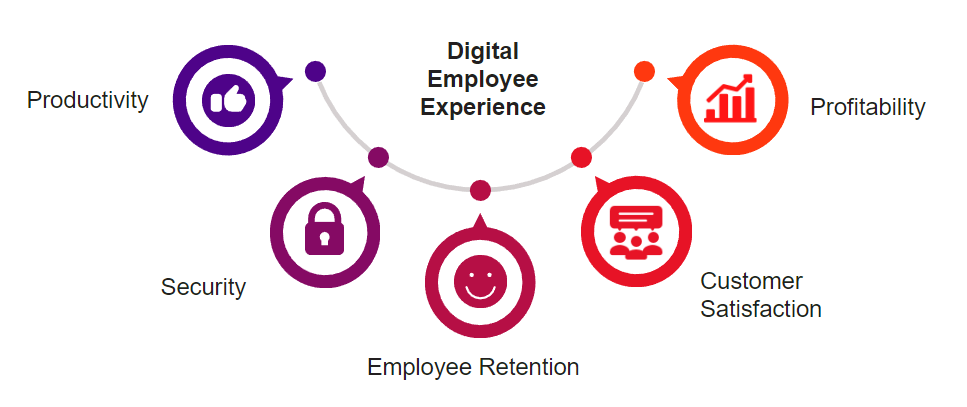Healing Bots Take Charge of Solving IT Problems to Enhance Employee Satisfaction
Imagine an Everywhere Work environment in which IT problems seem to magically resolve themselves before end users even realize there were issues. Printers miraculously start working again. Login issues vanish. Access to critical applications is seamless.
Before anyone starts believing in digital fairy godmothers, let’s give credit where it’s due: To the rise of healing bots: intelligent hyperautomation tools that proactively identify and address employee IT woes to improve employee experience.
Those woes abound as networks become more complex, with more devices connecting from more locations. Yet helpdesk automations like chatbots aren’t necessarily a panacea:
- According to Ivanti research, poor digital experiences are much too common: 57% of IT professionals, execs and users report “serious friction with work tech at least weekly.”
- 61% claim negative experiences with work tech impacts morale.
- Even when employees could call upon a chatbot/automation that’s as helpful as using a human, 58% still preferred human interaction.
This poses a quandary for ITSM teams: How can they shift left to tackle a multiplying miasma of incidents and issues and maintain good digital employee experience (DEX) when some users dislike digital remediation tools?
Self-healing automation bots provide an answer. When bots are fixing problems so there’s no visible issue to complain about, employees simply get on with their jobs. Meanwhile, your IT team can apply itself to more strategic and challenging work.
Employees who can do their jobs without interruptions are more engaged, more productive and more positive in their outlook. That contributes to how they serve customers, who in turn reward a vendor with loyalty and revenue.

The world before self-healing bots
Prior to self-healing bots, IT support followed a reactive approach. Employees running into problems submitted tickets to the help desk and potentially endured a protracted wait time before seeing a resolution. This approach is the culprit behind several issues:
- Increased ticket volume: Help desks become overwhelmed with backlogs of tickets for common, repetitive issues.
- Delays and frustration: Employees are forced to impatiently wait for resolutions while their work and productivity are disrupted.
- Limited proactivity: IT teams lack the resources to identify and prevent problems, so they’re trapped into being reactive.
All these highlight the need for a more proactive approach to IT support and their ability to enhance employee experience. Enter healing bots.
How healing bots are transforming IT
Since the earliest days of their introduction, self-healing bots have improved with multiple key advancements. Healing bots leverage automation and machine learning to anticipate and address employee IT problems before they occur. Their functionalities include:
- Real-time monitoring: Healing bots continuously monitor IT infrastructure and user activity.
- Predictive analytics: They analyze historical data to identify potential issues and predict user needs.
- Proactive prevention: Through issue detection and analytics, bots can not only identify problems but also take action to fix them.
- Cyber threat protection: Ensure secure access and protection against cyber threats without compromising employee flexibility to work from remote locations.
- Incident escalation: For complex issues they can’t address themselves, they can escalate them to the IT team with relevant data for faster resolution.
- Data and sentiment collection: Interactive ITSM survey bots can collect qualitative data and quantitative employee service ratings.
- Enhanced ease of use: Setting up and managing healing bots has become simpler for IT teams.
- Template libraries: Pre-built templates help in quickly deploying bots for common issues.
- ITSM integration: Seamless integration with existing IT service management ticketing systems allows for smoother workflows.
The ROI from using bots
One of the biggest concerns about any new technology is the return on investment you’ll get and the time it takes to realize that value. In solving for how to improve employee satisfaction, self-healing bots offer a clear path to value creation:
- Proactive efficiency: Bots handle routine issues and cut ticket volume and backlogs, freeing the IT team for more complex tasks so you get the best value from their skillsets.
- Cost reductions: Taking manual issue management off the IT team’s plate cuts process costs.
- Accelerated resolution: Incident management and resolutions are supercharged now that they're automated – and largely invisible.
- Better DEX: Faster resolution times and proactive problem-solving lead to happier employees.
- Increased productivity: Less downtime due to IT issues translates to increased employee productivity.
- In-depth monitoring: Bots’ comprehensive diagnostics can detect and notify IT of previously unreported issues and changes.
- Data-driven insights: Self-healing bots provide valuable data on user behavior and IT infrastructure health.
Implementing bots in your organization
If you're considering deploying self-healing bots, here's a basic roadmap for how to get started – and ultimately how to improve employee engagement.
Step 1: Analyze data to identify “botworthy” issues
Before you bring your new bots into play, it's crucial to pinpoint the tasks they can handle early on. Why? So you can learn and refine their capabilities and demonstrate success to stakeholders or management. Here's how:
- Examine past support ticket data: Utilize analytics and reporting tools to spot the most common and repetitive problems. These represent your "low-hanging fruit" ideal for initial automation efforts.
- Identify patterns: Look for recurring issues such as login troubles, requests for password resets or software setup inquiries that appear frequently.
- Choose based on potential impact: Consider not just how often issues occur, but also their impact on user efficiency. Automating resolution of widespread but simple problems permits your human staff to focus on more complex challenges.
Step 2: Set priorities by selecting the optimal tasks for bots
Not every issue is equally suited for self-healing bots. The "low-hanging fruit" are those IT problems that can be most successfully handled by automation tools.
- Target routine tasks: Automation tools like bots are most effective with tasks that are consistent and repetitive. Identify tasks that have straightforward procedures and definite outcomes.
- Assess complexity: Complex issues that require nuanced human judgment should remain with your skilled IT personnel. Automate issues that have a clear set of steps and solutions.
- Evaluate the impact on DEX: Ensure your bot deployment truly improves the employee experience. Opt for automating issues where consistent, accurate responses are key.
Step 3: Run a pilot program before full implementation
Launching your first bot rollout tool is a trial run that lets you fine-tune your approach and pinpoint any possible problems before widespread adoption.
- Begin at small scale: Select a narrow, manageable problem for automation. Your aim is to facilitate learning and adjustments, not to create the ultimate tool from the get-go.
- Solicit feedback from users and IT staff: Actively seek opinions on the tool's effectiveness. This feedback is crucial for identifying improvements and ensuring a smooth transition.
- Monitor important indicators: Track resolution speed, user satisfaction and ticket volume managed by the tool. This information is vital for evaluating the feasibility of broader automation.
Step 4: Optimize, refine, enhance, repeat
You bot may be great from the start, but it still requires regular attention and updates to flourish.
- Understand its learning capabilities: Some AI-powered self-healing bots are designed to learn based on user interactions. Monitor these capabilities and their success.
- Leverage user feedback: Their insights are endlessly valuable, so constantly review this feedback to spy opportunities for enhancing your bots. Update responses, tweak decision-making processes and ensure they keep learning and growing in capability.
- Regularly review and adjust: Continuously evaluate the tool's impact on issue resolution times, user satisfaction and the workload of the IT team. Use this data to refine your bots and extend them to tackle additional tasks.
Healing the future of Everywhere Work
Self-healing bots are a big leap forward in helping IT teams support Everywhere Work and the goal of shifting left and can be a key tool in how to enhance employee engagement. By proactively resolving issues, expediting shift left and supporting seamless DEX, they can have impact across the length and breadth of your organization. That's an impressive contribution from these invisible but tireless workers.
As self-healing bot technology keeps evolving, expect even more advanced capabilities and deeper integration. Eventually, they’ll help unlock a future in which IT support becomes almost invisible – prescient and proactive, but unintrusive in how it enables Everywhere Work.
